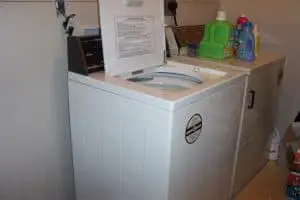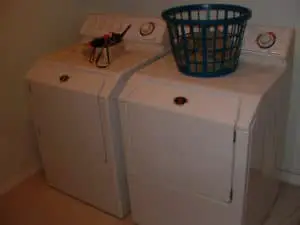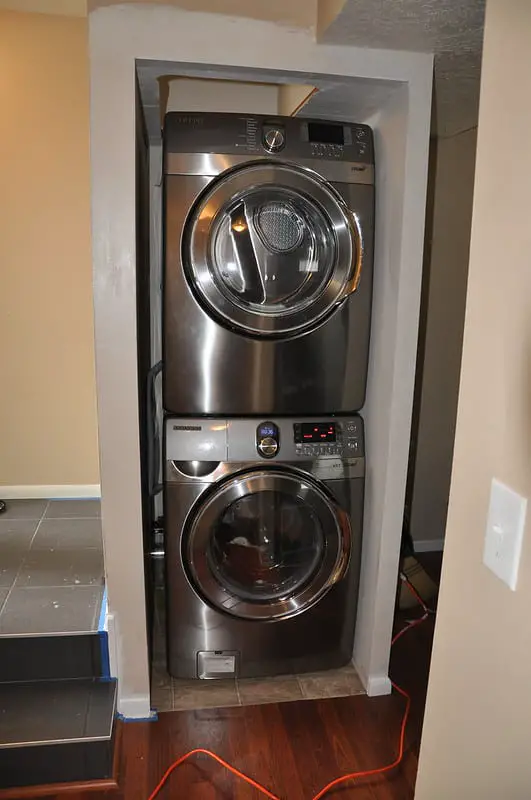Washers and dryers are enormous machines. Before installing them, you need to ensure the floor is strong and well-prepared to support their great weight.
Another thing is the way the two operate – it’s not uncommon for even the most modern washers to produce vibrations while in operation.
But that doesn’t mean every washer and dryer you’ll find is prone to vibrations; sometimes it boils down to the condition of your floor.
If the floor is weak, then vibrations are going to be felt all over, even if the machine isn’t that much vibration-prone.
Should You Reinforce The Floor For A Washer And Dryer?
In one word – YES. This is especially recommendable if you own an older manufactured home with a not-so-strong floor with vinyl parts. More often than not, washers/driers fail to work in harmony with manufactured home floors and end up producing vibrations or walking, two things that can give any homeowner a real headache.
Before You Even Reinforce Your Floor, Verify That There Is INDEED A Problem
Before even trying to make changes on your floor, it would be prudent you start by verifying if the problem is with the machine or the floor.
1. Take Your Machines Go Outside
- Start by taking the machine outside the house – somewhere with plywood, particleboard, or OSB mock floor (those are what most manufactured home floors are made from) or a floor-grade concrete pad (can be the patio, driveway, etc.).
- Ensure that it is level not to tilt the machine. Also, ensure that you can run a garden hose or pipe into the machine from your outdoor cold water source.
- Proceed to run the washer on cold water without detergent (so you don’t end up dealing with any type of your local waste draining laws).
- See if it still vibrates violently or hops/walks.
- Note that some washers will not drain properly if their drain hose does not go higher than their top (or at least the level of water level in the unit.
2. Flooring Problem?
If the washer/dryer works perfectly on the mock floor, then you most likely have a flooring problem.
However, before you start ripping out your flooring to reinforce the joists, it is recommended that you try to reinforce the top of the pre-existing flooring first.
You could try with a single extra, thick slab of plywood or a thin steel plate.
3. Take Note Of The Washer Vibrations


Most of the LG front-loading washers are known to vibrate violently and can walk when they go into the spin cycle.
It isn’t washers from LG alone.
Most of the washers in the market will vibrate regardless of how technologically advanced they are.
And if your home is wood-framed or manufactured before the year 2000, theirs is a strong chance part of the floor is vinyl, hence vulnerable to vibrations.
If you weren’t aware, you’d make so many service calls and even have the inner drum replaced, thinking the washer is at fault when in essence, there’s nothing wrong with your machine.
But first, confirm that the washer and/or dryer is level because the imbalance is one of the number one causes of undue vibrations even when everything else is right.
Related: Can Washing Machine Vibrations Damage A Manufactured Home?
Here Is To Reinforce Your Floor

Some brands equip their washers or dryers with technologies that help them cut on vibrations when installed on vulnerable floors.
For example, some washers from LG come with the LG SUSPENSE mode, which you can turn on if you use the machine on a wooden floor or flooring without strong support.
The worst thing is that old and weak floors can never work harmoniously with even mildly vibration-prone machines, even if you add some rubber feet.
You’d basically be forced to operate at low spin speeds for everything, and even then, the machine would still walk or vibrate.
At that point, you will need to explore different options to add a reinforcement on your laundry room floor:
- Reinforce your floor from underneath with 4×6 beams running perpendicular to the core support joists
- Re-adhere your sub-floor from top with a few additional screws, then proceed to replace vinyl (if your floor features vinyl or similarly wobbly materials) with ceramic tiles
Before going further with DIY or hiring a contractor, you should determine if one or both of the above options would resolve your issues.
You’ve probably heard similar stories involving front loaders that walk on cement basements, so a strong foundation is not always the solution.
Sometimes all you need is a top loader, and the problem would abate.
Here Are Two More Washer Dryer Installment\Reinforcement Remedies
Vibration and walking are two common washer and dryer problems that can be easily remedied by applying one or both of the following approaches (by these, we assume your washer or dryer is in good working condition and their harmonic balancers are in great balance and good shape)
1. Restrain the unit
Start by mounting an angle iron or wood or any other stable solid around the base to stop it from moving.
Also, ensure that you’ve added a thick foam strip or pad around the base region where the unit “rubs” the rest of this restraint frame.
This setup will absorb much of the vibrations and damp the energy.
2. Remove the leveling feet and replace them with urethane elastomer vibration/shock dampers (usually Sorbothane or similar material. These are not regular rubber feet).


Install them in such a way that they simply thread their way into the empty holes where the old leveling feet were (be careful to buy the right thread, although you can go for an adapter to make the product work if you didn’t get the sizing right).
These products are sold in many different styles, heights, etc., and though they may be expensive to acquire, they offer a far cheaper solution than reinforcing your floor or any similar approach.
Six Additional Facts You Should Know Prior To Installing A Washer And Dryer In A Manufactured Home

1. Consult An Expert
Virtually all front load washers you will find out there are designed to be installed on concrete surfaces, either over-pour or pad.
So, when shopping for one, consult an expert and choose one that will work with your plywood, particleboard, or OSB floor.
2. Get A Floor Drain?
It’s highly recommended that you have a floor drain in your laundry room. So, if you must reinforce your floor, don’t do away with a floor drain.
3. Reinforce The Floor AND The Wall?
If you must reinforce the floor, ask yourself: will you need to also reinforce the wall or both?
With what exactly?
That’s why you need to have a detailed conversation with your contractor before embarking on this project.
4. Additional Forces In Play
When a load (a washer or drier) is made to operate on the floor, there are many other forces and factors acting on it besides gravity.
Equipment that rotates at a given rotational rate will deal with many other forces that must be taken into account. If you have a very lightweight or a spindly structural system in place, they can only be tasked with carrying the vertical load.
Such a set up would be worthless when some lateral or uplift forces get involved.
These forces can multiply and cause some deflections that could end up creating cracks on the floor.
Lateral reinforcement/bracing or weight/mass are some of the ways used to minimize the effects produced by the surrounding structure.
Another method is isolating the equipment from the structure with isolation pads.
5. Consult With A Contractor
When reinforcing the floor, pre-fab joists measuring 12″ with a 2 3/4″ board at the top and bottom are perfect.
You also don’t need anything between joists.
However, because manufactured homes can be different with different sizes of floor, it is prudent that you seek the advice of an experienced contractor before buying the materials.
6. Building Codes
When it comes to dynamic and vibration loads, building codes might not be adequate (as in, what’s the worst you could do and still remain legal, though not necessarily right?).
You can attempt to add plenty of solid blocking in between the joists to boost the lateral stiffness and/or distribute the dynamic load horizontally.
Floor dynamics often depend on the frequencies that amplify the loads as well as responses.
However, most housing codes are old and can’t cure all issues in emerging or special situations.
Related: Can You Put a Rug Under a Washer and Dryer?
In a nutshell
So, should you reinforce the floor for a washer and dryer?
Absolutely. It is especially recommendable if you own an older manufactured home with a not-so-strong floor with vinyl parts.
Also, if your floor shows any form of weakness, proceed to reinforce it whether your home is old or new.
However, before even trying to make changes on your floor, it would be prudent you start by verifying if the problem is with the machine or the floor.
Begin by taking the machine outside the house – somewhere with plywood, particleboard, or OSB mock floor (those are what most mobile home floors are made from) or a floor-grade concrete pad (can be the patio, driveway, etc.).
Ensure that it is level not to tilt the machine.
If the machine doesn’t produce vibrations on the mock floor, then the problem is on the floor of your home.
You can reinforce your floor from underneath with 4×6 beams running perpendicular to the core support joists or choose to add a few screws to tighten it together.

